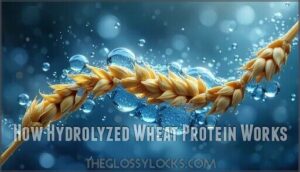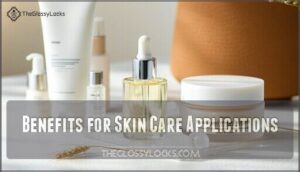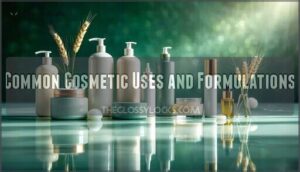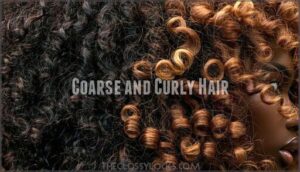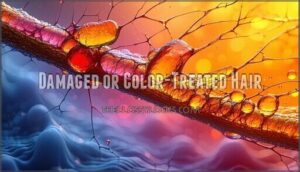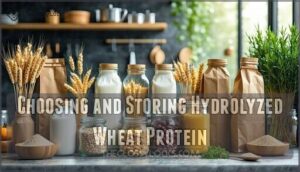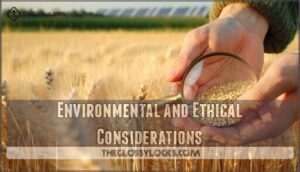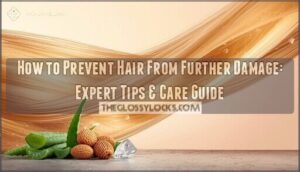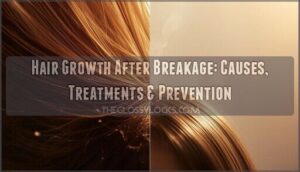This site is supported by our readers. We may earn a commission, at no cost to you, if you purchase through links.
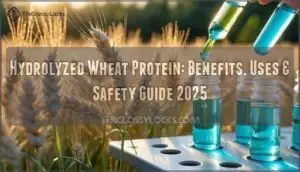 Wheat has a reputation for being off-limits to anyone with gluten concerns, but hydrolyzed wheat protein tells a different story in cosmetics.
Wheat has a reputation for being off-limits to anyone with gluten concerns, but hydrolyzed wheat protein tells a different story in cosmetics.
Far from the bread aisle, this ingredient slips into shampoos and serums, working beneath the surface to help hair and skin bounce back from daily stress. Its molecular structure, broken down through hydrolysis, lets it reach places whole proteins can’t—repairing, strengthening, and smoothing without weighing you down.
If you’re scanning labels for smarter choices or wondering how science shapes your beauty routine, understanding hydrolyzed wheat protein could change the way you care for your hair and skin.
Table Of Contents
- Key Takeaways
- What is Hydrolyzed Wheat Protein?
- How Hydrolyzed Wheat Protein Works
- Key Benefits for Hair Health
- Benefits for Skin Care Applications
- Common Cosmetic Uses and Formulations
- Suitability for Different Hair Types
- Safety, Allergies, and Gluten Concerns
- Potential Side Effects and Precautions
- Choosing and Storing Hydrolyzed Wheat Protein
- Environmental and Ethical Considerations
- Frequently Asked Questions (FAQs)
- How much wheat protein should I use on my hair?
- Is wheat protein safe for all hair types?
- Are there any potential risks associated with using wheat protein?
- Is there a difference between hydrolyzed and non-hydrolyzed wheat protein?
- Can hydrolyzed wheat protein be used in DIY recipes?
- Is hydrolyzed wheat protein compatible with other proteins?
- How does hydrolyzed wheat protein interact with silicones?
- Can hydrolyzed wheat protein be used in sunscreen formulas?
- Conclusion
Key Takeaways
Hydrolyzed wheat protein is made by breaking down wheat proteins into small peptides, which helps them penetrate hair and skin for better repair and moisture.
This ingredient strengthens hair fibers, improves shine, and locks in hydration, making it especially useful for damaged or fine hair types.
While hydrolyzed wheat protein offers benefits for both hair and skin, people with wheat allergies or gluten sensitivities should check labels and use caution.
Products containing hydrolyzed wheat protein support sustainability and are often vegan and cruelty-free, but proper storage and application are important to avoid buildup or irritation.
What is Hydrolyzed Wheat Protein?
Hydrolyzed wheat protein isn’t as complicated as it sounds—it’s simply wheat protein that’s been broken down into smaller, more useful pieces.
Understanding what this ingredient actually is can help you make better choices about the products you use on your hair and skin. Let’s break down its definition, where it comes from, and what makes it work so well in cosmetic formulations.
Ingredient Definition
Hydrolyzed wheat protein is a cosmetic ingredient that breaks down wheat proteins into smaller amino acids and peptides, making them small enough to slip into your hair strands and skin’s outer layer. This cosmetic-grade ingredient appears as an amber liquid with a CAS Number 70084-87-6 and the INCI designation "Hydrolyzed Wheat Protein."
The hydrolysis process—using acidic, alkaline, or enzymatic methods—reduces the molecular weight of wheat proteins, transforming them from large, complex structures into tiny fragments that your body can actually absorb and use.
Origin and Production Process
To grasp how this ingredient reaches your hair and skin, you need to know where it starts. Over 98% of commercial hydrolyzed wheat protein originates from purified wheat gluten—the protein-rich fraction extracted from wheat germ and flour. Here’s how manufacturers transform wheat protein into the amber liquid you see on ingredient labels:
- Wheat gluten isolation through washing and centrifugation removes starches and fibers, concentrating gliadin and glutenin proteins that make up 85–90% of wheat’s protein mass.
- Enzymatic hydrolysis uses proteases like papain at controlled temperatures (around 40°C) and pH 8.0, breaking protein chains into smaller peptides over two hours.
- Thermal deactivation heats the mixture to 130–160°C, stopping enzyme activity without destroying the newly formed peptides.
- Filtration and decolorization with activated carbon (1–4% concentration) removes impurities and lightens the color.
- Spray-drying converts the liquid into a free-flowing powder, preserving over 90% of its nitrogen solubility while creating peptides smaller than 2,000 Da—perfect for penetrating your hair cuticle and skin barrier.
Modern production achieves 98% yields with minimal waste, supporting a global market valued at $1.22 billion in 2022. The hydrolyzed wheat protein market is expected to reach USD 13,389.59 million by 2031.
Physical and Chemical Properties
Once the protein chains are dried and ready, their measurable traits determine how well they’ll work in your shampoo or serum.
Hydrolyzed wheat protein properties include a pH level between 4.5–5.0, water solubility near 95%, and molecular weight ranging from 500–2,000 Da after the hydrolysis process. Stability extends twelve months under cool, dark conditions.
Its COSMING REF No is 95940, while regulatory databases list EINECS/ELINCS No 274-351-8 and CAS 70084-87-6 for identification.
How Hydrolyzed Wheat Protein Works
Understanding how hydrolyzed wheat protein works starts with its unique molecular transformation. The hydrolysis process breaks wheat protein into smaller pieces that your skin and hair can actually use.
Let’s look at the three mechanisms that make this ingredient effective in cosmetic formulations.
Protein Hydrolysis Explained
When wheat protein undergoes hydrolysis, enzymes or acids act like molecular scissors, snipping the long protein chains into smaller pieces that your hair and skin can actually use. This process breaks down complex protein molecules into short-chain peptides and individual amino acids, greatly reducing their molecular weight.
Depending on the hydrolysis type—enzymatic, acidic, or alkaline—the resulting protein peptides vary in size and function, but all become water-soluble and ready to penetrate where intact proteins can’t reach.
Molecular Size and Absorption
After hydrolysis, you get peptides with molecular weights usually between 200 and 1,000 Daltons—small enough to slip past your skin’s outermost barrier and into hair’s cuticle layers. This size distribution determines absorption efficiency: smaller protein peptides penetrate deeper, while slightly larger protein molecules create a protective film on the surface.
That’s why Hydrolyzed Wheat Protein works both inside and outside your hair shaft and skin, delivering benefits at multiple depths. This protein is known to help strengthen hair strands.
Film-Forming Mechanism
As those small peptides land on your hair or skin, they don’t just sit there—they link together into a thin, flexible coating that smooths rough edges and locks moisture in place. This film formation creates protein adhesion across your hair structure and skin surface, offering environmental protection without feeling heavy or stiff. The film-forming properties allow protein molecules to work along each hair shaft, reinforcing cuticle smoothing while maintaining a moisture barrier that adapts when you move.
- Film flexibility lets the coating bend with your hair instead of cracking
- Protein adhesion anchors molecules to damaged spots on the cuticle
- Moisture barrier function prevents water loss from inside the hair shaft
- Cuticle smoothing fills microscopic gaps in your hair structure
- Environmental protection shields against humidity and pollutants
Key Benefits for Hair Health
Hydrolyzed wheat protein doesn’t just sit on your hair—it works its way in to repair damage from the inside out. Your hair gets stronger, shinier, and better at holding onto moisture when you use products with this ingredient.
Hydrolyzed wheat protein penetrates your hair to repair, strengthen, and boost shine while helping strands retain essential moisture
Here’s what you can expect when hydrolyzed wheat protein becomes part of your hair care routine.
Strengthening and Repair
Think of your hair fibers like rope—damaged strands fray and snap under tension. Hydrolyzed Wheat Protein delivers measurable Tensile Improvement, boosting wet hair strength in permed hair and outperforming collagen in thermally damaged strands.
You’ll see Cuticle Repair as protein fragments bond to damaged surfaces, filling rough spots and reducing hair breakage. The strengthening properties work deep inside your hair shaft, enhancing Elasticity Boost and providing Structural Support that helps damaged hair resist everyday stress and Breakage Reduction.
Shine and Smoothness
Your hair reflects light like a polished surface—when the outer cuticle lies flat and smooth, you get that glossy, salon-fresh shine. Hydrolyzed Wheat Protein’s film-forming ability delivers Cuticle Smoothing that boosts your hair’s Reflective Properties:
- Enhanced Highlights appear more vibrant as protein fragments coat each strand
- Silky Texture emerges from improved hair conditioning and antistatic properties
- Manageability Boost makes styling easier while maintaining hair elasticity and natural shine
Moisture Retention
When moisture escapes from your hair shaft, you’re left with brittle, lifeless strands that snap at the slightest stress—but Hydrolyzed Wheat Protein acts like a protective seal that locks water molecules inside where they belong.
Its Film Formation creates a Barrier Function that prevents water loss, while Humectant Properties draw moisture from the air.
This dual action improves Hair Elasticity and maintains ideal moisture retention, leaving your hair flexible and resilient instead of dry and prone to breakage.
Benefits for Skin Care Applications
While hydrolyzed wheat protein works wonders for your hair, it’s equally impressive for your skin. This ingredient offers several mechanisms that address common skin concerns, from dryness to visible signs of aging.
Let’s look at three key ways it benefits your skin’s health and appearance.
Hydration and Elasticity
One of hydrolyzed wheat protein’s standout talents for skin is its ability to grab water molecules and hold them close to the surface, which directly translates to better hydration and improved elasticity.
The film benefits come from its protective layer, which helps maintain moisture balance and reinforces skin suppleness.
As water binding occurs, the anti-irritant properties kick in, creating smoother, more resilient skin that bounces back when pressed.
Anti-Aging Effects
Beyond hydration, hydrolyzed wheat protein delivers measurable antiaging properties through cellular protection and radical neutralization. Research shows it addresses aging at multiple levels:
- Wrinkle reduction – Studies report smoother facial lines and improved skin elasticity after 4–8 weeks of use, thanks to enhanced collagen synthesis and moisture retention
- Barrier function – It cuts water loss and aids tissue repair by boosting procollagen and ceramide levels
- Inflammation regulation – The ingredient suppresses enzymes that break down collagen while reducing markers of aging-related inflammation
This means fewer fine lines and firmer skin over time.
Texture and Firmness Improvement
Firmer, more supple skin follows when hydrolyzed wheat protein tightens and plumps the surface through a combination of water binding and film formation. The peptide film pulls water into cells, which swells tissue and softens rough patches. That’s why you’ll notice improved suppleness and reduced wrinkles after consistent application. Regular use strengthens skin elasticity and refines skin texture, creating a visible lift.
| Benefit | Mechanism | Timeline |
|---|---|---|
| Improved Suppleness | Water binding + protein film | 2–4 weeks |
| Skin Firmness | Cellular plumping | 3–6 weeks |
| Smooth Texture | Surface refinement | 1–3 weeks |
| Skin Elasticity | Collagen support | 4–8 weeks |
| Moisture Retention | Barrier enhancement | Immediate–2 weeks |
Common Cosmetic Uses and Formulations
You’ll find hydrolyzed wheat protein in a wide range of beauty products, from your morning shampoo to your nighttime face cream. This ingredient works across multiple formulations because of its small molecular size and film-forming abilities.
Let’s look at where you’re most likely to encounter it in your cosmetic routine.
Hair Care Products
In shampoos, conditioners, and styling products, you’ll find hydrolyzed wheat protein working to strengthen strands, smooth rough cuticles, and add noticeable body without the heavy feel that weighs hair down.
Shampoo formulations use it to gently coat each hair fiber, while conditioner benefits include improved hair texture and moisture retention for dry hair.
Protein treatments and hair sprays rely on its film-forming ability to boost hair shine and support scalp health.
Skin Care Products
Skin care formulations use hydrolyzed wheat protein for similar reasons—it binds moisture, smooths rough patches, and leaves a protective layer that helps your complexion look plumper and more resilient. You’ll find it in products designed for hydration benefits and texture improvement, including:
- Facial lotions that boost skin conditioning
- Eye creams targeting anti-aging properties
- Serums focused on skin hydration
- Masks formulated for sensitive skin
- Toners that support product formulation stability
Moisturizers and Serums
Moisturizers and serums pack hydrolyzed wheat protein into lightweight, fast-absorbing formulas that deliver amino acids directly to your skin’s surface.
These facial moisturizers and serums improve serum penetration while maintaining moisturizer compatibility, creating hydration synergy that reinforces your skin barrier.
You’ll notice improved skin hydration, fine line reduction, and better moisturizing effects when the protein works alongside other active ingredients in your routine.
Suitability for Different Hair Types
Your hair type plays a big role in how hydrolyzed wheat protein performs in your routine. Fine strands respond differently than thick, textured curls, and damaged hair has unique needs altogether.
Here’s what works best for each type.
Fine and Thin Hair
If your hair lacks volume and feels like it could use a little backbone, hydrolyzed wheat protein might be exactly what you need. The small protein fragments reinforce individual hair fibers without weighing them down, giving you noticeable lift at the roots. Here’s what to expect:
- Your strands gain structural support that creates natural hair volume
- Lightweight formulas prevent the flat, heavy feeling other proteins cause
- You’ll notice improved scalp health as the ingredient doesn’t clog follicles
- Regular use aids hair repair while maintaining bounce and movement
Just watch for protein overload—fine hair needs less frequent application than damaged types.
Coarse and Curly Hair
When you’re dealing with thick, textured strands that seem to have a mind of their own, hydrolyzed wheat protein steps in like a personal coach for unruly hair. The protein fragments penetrate deep into hair fibers to improve curl definition and frizz control, while the film-forming action locks in moisture balance.
You’ll find your hair treatments work better because hydrolyzed wheat protein improves product absorption, strengthening strands from within for breakage prevention and genuine hair repair.
Damaged or Color-Treated Hair
Color treatments and chemical processing strip away your hair’s natural defenses, leaving protein bonds fractured and cuticles lifted. But hydrolyzed wheat protein works like a repair crew that patches those weak spots from the inside out.
You’ll notice improved elasticity and color retention because the film-forming action seals the cuticle, preventing breakage and offering UV protection.
Hair masks with conditioning properties deliver hydrolyzed wheat protein deep into damaged sections without protein overload, making your hair treatments more effective for lasting hair care results.
Safety, Allergies, and Gluten Concerns
Before you try products with hydrolyzed wheat protein, it’s important to know how they might affect your health and safety. Some people have specific sensitivities that deserve extra attention. Here’s what you should keep in mind.
Wheat and Gluten Sensitivities
Did you know hydrolyzed wheat protein isn’t gluten-free? If you have celiac concerns, gluten sensitivity, or wheat allergies, you’ll want to pay close attention.
Hydrolysis safety varies, and gluten detection in these products can be tricky. NCGS symptoms—like skin rashes or fatigue—may still occur, so always check labels and consider your own gluten intolerance risk.
Allergic Reactions and Precautions
Redness, itching, or hives are classic allergy symptoms linked to wheat protein and allergic reactions. For safe usage, patch testing is smart—especially if you know your allergy risk or gluten sensitivity.
Product buildup can also trigger adverse reactions, so watch for stiffness or irritation. If you notice any signs, stop immediately and consult a healthcare professional.
Regulatory and Labeling Guidelines
Once you’ve checked for allergies, it’s worth knowing how labels and regulations help you make safer choices with hydrolyzed wheat protein in your routine. Ingredient Disclosure and Allergen Labeling are required under Regulatory Compliance.
International Standards and Certification Requirements help products meet safety guidelines. Regulations on hydrolyzed wheat protein also address gluten content, helping you avoid unexpected allergic reactions.
Potential Side Effects and Precautions
Even though hydrolyzed wheat protein is popular in beauty products, it’s important to know how your skin and hair might react.
Some side effects and precautions are worth considering before you add it to your routine. Here’s what you should keep in mind.
Overuse and Product Buildup
Buildup symptoms often show up as dullness or a heavy residue that resists styling. To prevent this, pay attention to product frequency and application methods in your hair care or skin care routine.
Clarifying shampoos help with residue removal, keeping formulations balanced. Adjust your product formulation and stability for best results, especially if you’re layering multiple protein-based treatments.
Skin and Eye Irritation
Just as buildup can weigh down your routine, you might notice a bit of tingling or discomfort if hydrolyzed wheat protein gets too close to sensitive areas like your eyes or compromised skin.
Watch for these irritation symptoms:
- Redness or stinging
- Allergic reactions to hydrolyzed wheat protein
- Contact dermatitis in sensitive skin
- High product concentration issues
- Rinse thoroughly to minimize side effects
When to Avoid Use
Sometimes, it’s best to skip products with hydrolyzed wheat protein altogether, especially if you notice ongoing irritation or have a history of wheat or gluten allergies. Those with gluten sensitivity, wheat allergy, or compromised skin should avoid use.
Product overload can also trigger potential side effects. Avoid infant use, and always check labels for safety of hydrolyzed wheat protein.
Choosing and Storing Hydrolyzed Wheat Protein
If you’re thinking about using hydrolyzed wheat protein, it’s important to know what to look for and how to keep it fresh. The right choice can make a big difference in your results. Here are some key things to think about before you get started.
Certified Organic and Vegan Options
For instance, certified organic products offer label transparency, so you know exactly what’s in your formula. Vegan sourcing means the ingredient is plant protein—no animal derivatives.
Many brands now emphasize cruelty-free practices and ethical concerns, so you can select organic ingredients and vegan alternatives that match your standards without compromising on quality or performance.
Storage and Shelf Life
Hydrolyzed wheat protein keeps best in cool, dry places, away from direct sunlight and heat—think of your linen closet, not the bathroom shelf. Ideal conditions help maintain shelf stability, while airtight containers limit moisture.
Watch for changes in color or odor, which signal expiration. Proper storage of hydrolyzed wheat protein protects product stability and maximizes shelf life.
Environmental and Ethical Considerations
When you’re choosing products with hydrolyzed wheat protein, it’s worth thinking about how they’re made and sourced. Ethical and environmental factors can shape what ends up on your shelf. Here’s what you should know before making your pick.
Renewable Sourcing and Sustainability
Ever wondered how your skincare connects to the planet’s health? Sourcing hydrolyzed wheat protein from renewable sources now means:
- Less deforestation, thanks to certified sustainable agriculture
- Waste valorization transforms by-products into valuable ingredients
- Green chemistry reduces energy use and emissions
- Regional initiatives and industry standards keep environmental concerns front and center for plant-based sources
Vegan and Cruelty-Free Status
If you’re curious whether hydrolyzed wheat protein fits into a vegan or cruelty-free lifestyle, it’s worth knowing that its plant-based origins and ethical production practices often line up with these values.
Here’s a quick comparison:
| Aspect | Hydrolyzed Wheat Protein |
|---|---|
| Animal Testing | Rare, but check claims |
| Vegan Certification | Often available |
| Ingredient Sourcing | Plantbased, renewable sources |
| Ethical Concerns | Low, if sourced responsibly |
| Cruelty-Free Claims | Common in vegan formulations |
Regulatory Standards and Certifications
Global regulations and certification bodies set the rules for ingredient safety and labeling requirements. For instance, compliance standards like organic certification of hydrolyzed wheat protein or California Prop 65 statements guide safe product usage.
Cosmetic grade ingredients undergo safety analysis, so when you check for these certifications, you’re ensuring the product meets strict requirements for your peace of mind.
Frequently Asked Questions (FAQs)
How much wheat protein should I use on my hair?
You’ll want to use hair care products with Hydrolyzed Wheat Protein at a sweet spot concentration, usually 5–2%.
Application frequency depends on hair porosity—once weekly helps avoid protein overload while maximizing the benefits of hydrolyzed wheat protein.
Is wheat protein safe for all hair types?
Your hair type porosity matters when using wheat protein. Some hair care products may cause protein overload risk, especially for low-porosity hair.
Always try sensitivity testing tips, explore hydrolyzed alternatives, and pair products wisely for best results.
Are there any potential risks associated with using wheat protein?
Potential side effects of Hydrolyzed Wheat Protein include skin irritation, eye irritation, and allergic reactions, especially for those with wheat allergies or gluten sensitivities.
Product buildup can also occur, making hair feel coated or stiff if overused.
Is there a difference between hydrolyzed and non-hydrolyzed wheat protein?
You’ll notice hydrolyzed wheat protein has a lower molecular weight than non-hydrolyzed wheat protein, which boosts absorption rate.
Protein hydrolysis changes protein structure, affecting cosmetic effects, production cost, and suitability for those sensitive to gluten.
Can hydrolyzed wheat protein be used in DIY recipes?
You can use hydrolyzed wheat protein in DIY formulations for both haircare and skincare.
Pay attention to concentration levels, recipe compatibility, and storage considerations.
Always follow safety precautions to get the most out of hydrolyzed wheat protein benefits in cosmetic uses.
Is hydrolyzed wheat protein compatible with other proteins?
Like pieces in a puzzle, most cosmetic proteins—including hydrolyzed wheat protein—work well together. Protein Interactions can boost Formulation Stability, Synergistic Effects, and Enhanced Performance, especially for hydrolyzed wheat protein in skincare and haircare applications.
How does hydrolyzed wheat protein interact with silicones?
You’ll find Silicone Compatibility and Performance Synergy are central in hair care applications. Silicones can improve Hydrolyzed Wheat Protein benefits, but Buildup Potential may affect hair texture.
Product Formulation balances moisturizing properties and film-forming properties for best results.
Can hydrolyzed wheat protein be used in sunscreen formulas?
In sunscreen formulas, hydrolyzed wheat protein isn’t a direct UV protection or SPF boosting agent. Its role focuses on skin conditioning, but formulation challenges and stability concerns may arise, especially for those with skin sensitivity or gluten allergies.
Conclusion
Strengthening, smoothing, and supporting—hydrolyzed wheat protein does more than just sit on the label. It works quietly, building resilience for your hair and skin, adapting to different needs, and respecting sensitivities.
When you choose products mindfully, you’re not just following a trend; you’re engaging with science that respects both safety and innovation. Like a bridge between nature and technology, this ingredient invites you to rethink what’s possible in your daily routine, one application at a time.
- https://patents.google.com/patent/CN101627793A/en
- https://pmc.ncbi.nlm.nih.gov/articles/PMC11227950/
- https://en.wikipedia.org/wiki/Hydrolyzed_vegetable_protein
- https://straitsresearch.com/report/hydrolyzed-wheat-protein-market
- https://media.market.us/wheat-protein-is-expanding-the-popularity-of-plant-based-diets-significantly/

